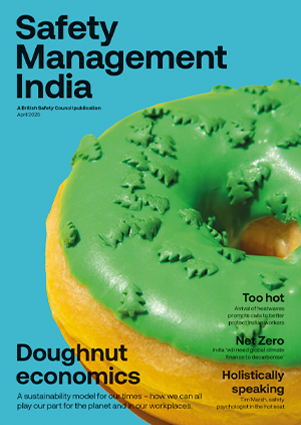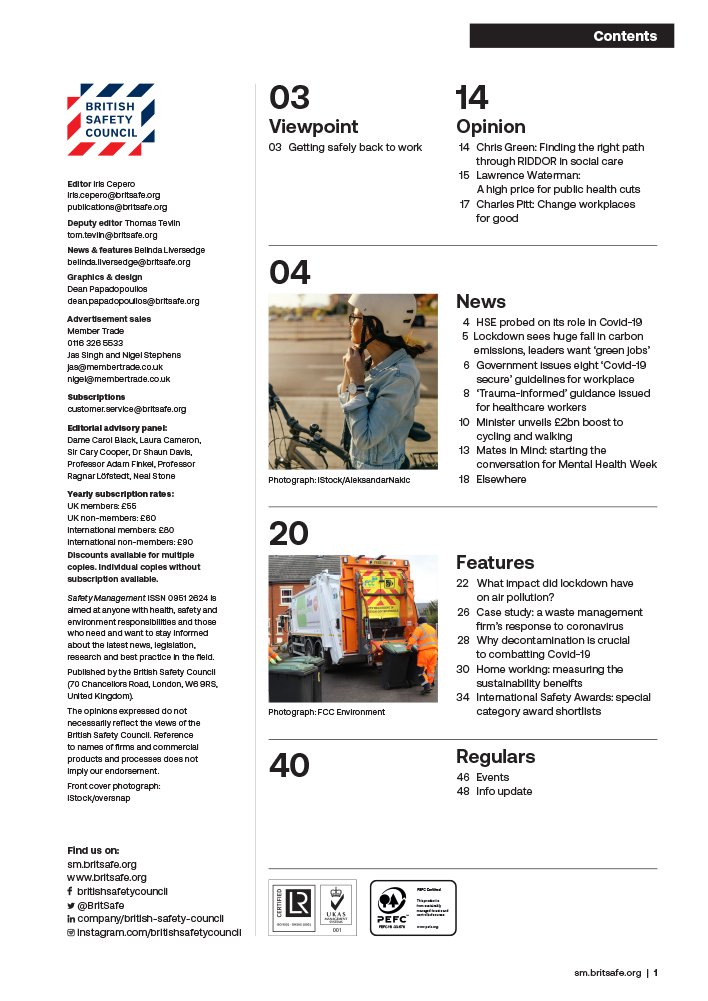Building Information Modelling has traditionally been used to develop and share digital information, plans and 3D models for the efficient design and construction of buildings and other physical assets, but it also holds huge promise for ensuring the safety of construction projects, from the design phase through to the management of the build itself.
Features
How Building Information Modelling can improve the management and delivery of occupational safety and health
Building Information Modelling (BIM) has been widely adopted within the architecture, engineering, construction and operation (AECO) sector in the UK, with the promise of aiding more efficient delivery for projects that are ever-increasing in complexity and scope.
 Illustration: iStock/Franck-Boston
Illustration: iStock/Franck-Boston
The construction industry is also a notoriously hazardous industry – the UK’s Health and Safety Executive (HSE) recently revealed that there were 138 work-related deaths in 2023/24 (provisional figure), with the highest number of 51 occurring in construction.
Research has shown that the lack of digital occupational safety and health (OSH) information is a significant factor contributing to the poor performance of OSH management in construction. It is vital, therefore, that the AECO sector understands how to best implement BIM to improve OSH processes.
BIM applied to OSH management has not yet yielded the same benefits as other BIM applications, such as in architectural or structural design. Recent academic literature indicates that BIM has the potential to optimise OSH management and that the construction industry, especially larger general contractors, are starting to adopt these kinds of technologies for use in OSH management.
BIM has the potential to be used for the planning of OSH and its use at the early stages of a number of projects has been linked to an improvement in safety conditions during construction. In 2018, the British Standards Institute (BSI) launched a new standard PAS 1192-6 – Specification for collaborative sharing and use of structured Health and Safety information using BIM. This was a milestone in this area and it still remains a reference document in this field. Meanwhile, ISO (International Organization for Standardization) is preparing an international standard: ISO 19650-6 related to OSH.
BIM can be used in several OSH areas, including the following:
Document/contractual management
Experience in the AECO sector indicates that better collaboration between stakeholders is needed in this area. Information sources used in projects (whether analogue or digital), contain hundreds of attributes and often lack structure, which can hinder the interpretation of relevant information. BIM provides essential tools to organise this type and volume of information.
A Common Data Environment (CDE) provides stakeholders with the ability to access, from any communication device with internet access, a standard compliance environment to collect, store and manage data documents and 3D models in a collaborative manner. This includes health and safety plans, approval of subcontractors, workers and the equipment used.
Another benefit of BIM is that it sets out clients’ BIM requirements on the project, including for OSH, in an Exchange of Information Requirements (EIR) document. This describes what, when, how and for whom information in connection with the project is to be produced. The contractor responds to those requirements through a BIM Execution Plan (BEP). BIM also facilitates cost control related to OSH, which enables automated extraction of OSH equipment quantities, and forecasting and budgeting of safety equipment and associated activities, which increases financial control and accuracy.
Risk identification and assessment
The usual approach to risk assessment is based on two-dimensional drawings along with numerous and sometimes convoluted procedures. These may be perceived by managers as being too bureaucratic and may not always be properly integrated into work planning – limiting the possibility of identifying and analysing dangers before the construction phase starts.
BIM enables representation of risks in the design phase, which improves the capacity of actors to improve timely risk identification and mitigation. It also provides better knowledge of areas or periods when there may be a higher level of risk, making it easier to identify potential constraints. BIM also provides the opportunity to test several OSH solutions in the form of simulations.
Training
When it comes to safety training, companies tend to adopt a variety of traditional training systems through lectures, videos or demonstrations.
These methods have pedagogical limitations, including:
- Lack of hands-on training elements
- Lack of ease to modify or update material
- Lack of opportunity for a practitioner to test their understanding prior to physically performing the task
- Inability to represent the complexities and spatial characteristics of the specific construction sites
- Inability to adapt to a multilingual workforce.
Incorporating BIM offers an opportunity to tackle some of these challenges – for example, to overcome the language barrier (using a 3D model) and to present virtual experiences using different scenarios that would previously have been impossible, dangerous, hard or expensive to replicate. This results in a more effective way to share information, improving communication between actors and providing outputs which are more easily used for training purposes.
Site planning
Construction sites are usually made up of several temporary facilities (such as office and storage spaces, working areas, site infrastructures, lifting equipment, scaffolds, etc.) and corresponding access points which frequently impact on construction safety, quality, speed and profitability.
The typical working documents are the tendering documents – which typically do not include temporary facilities except for exceptionally complex temporary facilities such as cofferdams.
BIM has the potential to improve site planning by allowing the location of temporary facilities to be assessed and managed more easily with early visualisation of site arrangements (see Figure 1) at different periods in time. This provides a more detailed analysis of the construction site logistics to enhance the flows of materials and equipment and to optimise the space available at the construction site.
 Figure 1: Site modelling. Illustration: Digital4OSH
Figure 1: Site modelling. Illustration: Digital4OSH
For example, safety perimeters can be visualised using a 3D model; and the visual link between the schedule and construction site conditions can then facilitate better decision-making during both the planning and the construction stages.
Task planning
Shortcomings in traditional planning techniques can lead to ineffective workspace management or schedule conflicts between activities, which have been identified as major causes of high accident rates.
From the point of view of OSH, task planning presents several difficulties, specifically:
- Safety planning is usually done separately from the construction planning process
- Traditional safety planning is carried out by manual means which are labour-intensive, tend to be error-prone, and are often highly inefficient
- Most planning techniques cannot account for the spatial feature of each activity and consider only construction schedules
- There are often unexpected last-minute changes leading to new tasks that need to be taken into account
- Digital schedules are rarely updated frequently enough to reflect all operations under way at any given point in time.
BIM has the following advantages in terms of work planning:
- It enables the upfront simulation of the sequence of tasks, leading to early identification of various scenarios (see Figure 2), which allows for each scenario to be evaluated
- It streamlines the management of changes in materials, equipment or workforce, decreasing the number of doubts about the project
- Clashes can be quickly eliminated or mitigated
- Construction or installation sequences can be modelled and assessed in terms of feasibility
- Algorithms can automatically generate detailed schedules for temporary structure installation which are not shown in the original contractor’s schedule programme
- It shows the construction sequence from a safety stance, therefore reducing the need for improvisation or last-minute solutions
- It allows for the swift translation of planning changes into safety-related changes.
 Figure 2: Task modelling. Illustration: Digital4OSH
Figure 2: Task modelling. Illustration: Digital4OSH
Task monitoring
Site monitoring is traditionally based on text-based standalone checklists which are neither sufficiently timely nor accurate enough to successfully identify and record breaches. BIM can potentially improve monitoring by:
- Visualising what is foreseen in safety procedures, for each work front
- Helping to compare work planned and work done
- Allowing for real-time management of non-conformities.
Emergency planning and accident investigation
The first step in minimising risk in emergencies is to set up contingency plans for each identified scenario. Using BIM, this process can be improved due to the ease with which users can visualise safe emergency response procedures, (such as evacuation routes and shelters); optimise the location of firefighting equipment; and illustrate the flaws found in current plans.
 Illustration: iStock/Gearstd
Illustration: iStock/Gearstd
Although research into the use of BIM for OSH management continues to progress, several challenges remain.
Firstly, there are no universally agreed independent metrics that enable the monitoring of implementation and dynamics of BIM for OSH implementation; secondly, there are no channels to enable the exchange of lessons learned about BIM for OSH.
The Digital4OSH research group, whose aim is to maximise the benefits from implementing these technologies in OSH settings and reduce the high levels of fatalities in construction, is preparing a novel digital platform in the form of an ‘Observatory’ designed to address these gaps.
Observatories have several advantages for stakeholders, including identifying technological developments; providing, through multiple data sets, a better understanding of context of patterns of change; allowing for comparative assessment and benchmarking to be undertaken; and developing and testing tailored responses that can then be shared as best practice.
The proposed Observatory will consist of three main components:
- An online collaborative platform that hosts a collection of information about BIM4OSH practices and enables knowledge sharing.
- A statistical data collection instrument (barometer) using a standard online survey for measuring longitudinal implementation of BIM4OSH that will monitor trends in different countries and companies in a longitudinal approach.
- Collection, analysis, contextualisation and storage (through a repository) of lessons learned, best practices, barriers and trends. These will be obtained from successful case studies based on projects from different stakeholders which have a good level of BIM implementation and that can serve as anchor points for knowledge transfer to less mature stakeholders.
The Observatory platform is under development and a prototype is already available and being implemented.
Initial work on the capture of lessons learned has already been carried out though the implementation in the Ferrovial Laing O’Rourke (FLO) joint venture on the Thames Tideway Tunnel (Tideway) super sewer project in London. The results were published in several papers: Real world lessons that can assist construction organisations in implementing BIM to improve the OSH processes and Lessons learned from the use of virtual reality for occupational safety and health training in Thames Tideway Tunnel.
Conclusion
Applying BIM to OSH management has great potential to assist in the optimisation of construction timescales and costs, with increased production efficiency, and a better connection between production and OSH management. Some challenges still need to be overcome – for example, working out how to implement the platform in SMEs, where resources dedicated to research and development are scarcer; subcontractors not being interested in using BIM; resistance by contractors to changing from traditionally used processes; and associated costs and time linked to upskilling.
BIM is only one of many digital technologies that are currently being adopted in the AECO sector (for example, virtual reality, artificial intelligence, artificial intelligence machine learning). The connections between these other technologies and BIM will certainly be the object of further research.
Manuel Tender is group leader of the research team at Digital4OSH.
Digital4OSH is a group of construction researchers and professionals from the UK and Portugal, who focus on applying Key Technological Developments to realise OSH outcomes. For more information on the work of the Digital4OSH Research Group go to:
To potentially participate in the research programme, email Digital4OSH’s group leader, Manuel Tender:


FEATURES

India’s path to net zero: a work in progress
By Orchie Bandyopadhyay on 08 April 2025
India is implementing a variety of clean energy measures to hit its target of net zero greenhouse gas emissions by 2070, including plans to rapidly scale up the generation of nuclear power. However, climate experts say significant finance will be required from developed countries to phase out coal power, accelerate renewables deployment and expand the national electricity grid.

Too hot to handle: early arrival of heatwaves in India sparks calls for action to protect workers and the public
By Orchie Bandyopadhyay on 08 April 2025
Temperatures in India in February 2025 were the hottest since records began over a century ago, prompting warnings the country needs to urgently step up efforts to protect both workers and the general population from the health risks posed by extreme heat and humidity.

